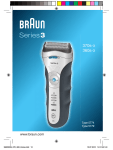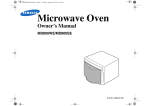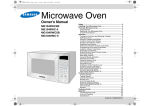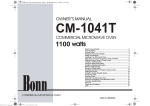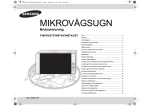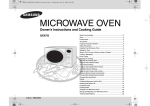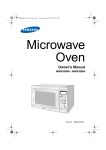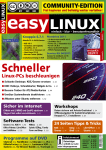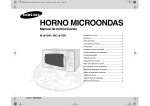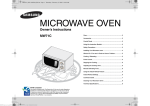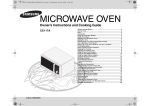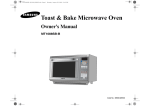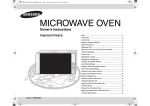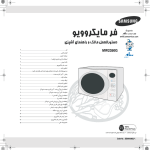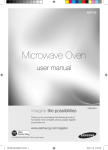Download Samsung MW840WF/ZAM User Manual
Transcript
t~_[W~mTiUGGwGXGG{ SGqG_SGYWW]GGXWa[_Ght
Microwave Oven
Owner’s Manual
MW840WF
Safety .......................................................................................... 2
Your New Microwave oven........................................................ 4
Checking Parts ......................................................................... 4
Warranty and Service Information ............................................ 4
Setting Up Your Microwave Oven ............................................ 4
Control Panel Buttons............................................................... 5
Operation .................................................................................... 6
Setting the Clock ...................................................................... 6
Using the Pause/Cancel Button................................................ 7
Using the Instant Cook Buttons ................................................ 7
Using the One Minute + Button ................................................ 8
Defrosting Automatically........................................................... 8
Setting Cooking Times & Power Levels ................................... 9
One-stage Cooking................................................................... 9
Multi-stage Cooking.................................................................. 9
Cooking Instructions ............................................................... 10
Cooking Utensils..................................................................... 10
Testing Utensils ...................................................................... 10
Cooking Techniques............................................................... 11
General Tips ........................................................................... 11
Auto Defrosting Guide ............................................................ 12
Cooking Guide........................................................................ 13
Recipes................................................................................... 15
Cookware Guide....................................................................... 16
Appendix................................................................................... 19
Troubleshooting Guide ........................................................... 19
Care and Cleaning.................................................................. 19
Specifications ......................................................................... 20
Code No.: DE68-03300A
t~_[W~mTiUGGwGYGG{ SGqG_SGYWW]GGXWa[_Ght
Safety
PRECAUTIONS TO AVOID POSSIBLE EXPOSURE
TO EXCESSIVE MICROWAVE ENERGY
Important Safety Instructions.
Read Carefully and keep for future reference.
Before cooking food or liquids in your microwave
oven, please check that the following safety
precautions are taken.
Failure to observe the following safety precautions may result in harmful
exposure microwave energy.
(a) Under no circumstances should any attempt be made to operate the
oven with the door open or to tamper with the safety interlocks (door
latches) or to insert anything into the safety interlock holes.
(b) Do not place any object between the oven door and front face or
allow food or cleaner residues to accumulate on sealing surfaces.
Ensure that the door and door sealing surfaces are kept clean by
wiping after use first with a damp cloth and then with a soft dry cloth.
(c) Do not operate the oven if it is damaged until it has been repaired by
a qualified microwave service technician trained by the
manufacturer.
1. DO NOT use any metallic cookware in the microwave oven:
•
Metallic containers
•
Dinnerware with gold or silver trimmings
•
Skewers, forks, etc.
Reason: Electric arcing or sparking may occur and may damage the
oven.
2. DO NOT heat:
•
Airtight or vacuum-sealed bottles, jars, containers
Ex) Baby food jars
•
Airtight food.
Ex) Eggs, nuts in shells, tomatoes
It is particularly important that the oven door closes properly and that
there is no damage to the:
3.
(1) Door, door seals and sealing surfaces
(2) Door hinges (broken or loose)
(3) Power cable
(d) The oven should not be adjusted or repaired by anyone other than a
properly qualified microwave service technician trained by the
manufacturer.
4.
5.
6.
7.
8.
2
Reason: The increase in pressure may cause them to explode.
Tip:
Remove lids and pierce skins, bags, etc.
DO NOT operate the microwave oven when it is empty.
Reason: The oven walls may be damaged.
Tip:
Leave a glass of water inside the oven at all times. The water
will absorb the microwaves if you accidentally set the oven
going when it is empty.
DO NOT cover the rear ventilation slots with cloths or paper.
Reason: The cloths or paper may catch fire as hot air is evacuated from
the oven.
ALWAYS use oven gloves when removing a dish from the oven.
Reason: Some dishes absorb microwaves and heat is always
transferred from the food to the dish.The dishes are therefore
hot.
DO NOT touch heating elements or interior oven walls.
Reason: These walls may be hot enough to burn even after cooking has
finished, even though they do not appear to be so. Do not allow
inflammable materials to come into contact with any interior
area of the oven. Let the oven cool down first.
To reduce the risk of fire in the oven cavity:
•
Do not store flammable materials in the oven
•
Remove wire twist ties from paper or plastic bags
•
Do not use your microwave oven to dry newspapers
•
If smoke is observed, keep the oven door closed and switch off or
disconnect the oven from the power supply
Take particular care when heating liquids and baby foods.
ALWAYS allow a standing time of at least 20 seconds after the
•
oven has been switched off so that the temperature can equalize.
•
Stir during heating, if necessary, and ALWAYS stir after heating.
t~_[W~mTiUGGwGZGG{ SGqG_SGYWW]GGXWa[_Ght
Safety
•
•
•
IMPORTANT SAFETY INSTRUCTIONS
Take care when handling the container after heating. You may burn
yourself if the container is too hot.
A risk of delayed eruptive boiling exists.
To prevent delayed boiling and possible scalding, you should put a
plastic spoon or glass stick into the beverages and stir before,
during and after heating.
Reason: During the heating of liquids the boiling point can be delayed;
During cooking, you should look into the oven from time to time when food is being
heated or cooked in disposable containers of plastic, paper or other combustible
materials.
IMPORTANT
Young children or infirm persons should NEVER be allowed to use or play with the
microwave oven. Nor should they be left unattended near the microwave oven when it
is in use. Items of interest to children should not be stored or hidden just above the
oven.
this means that eruptive boiling can start after the container is
removed from the oven. You may scald yourself.
•
In the event of scalding, follow these FIRST AID instructions:
•
•
•
Immerse the scalded area in cold water for at least 10 minutes.
Cover with a clean, dry dressing.
Do not apply any creams, oils or lotions.
WARNING:
•
NEVER fill the container to the top and choose a container that is
wider at the top than at the bottom to prevent the liquid from boiling
over. Bottles with narrow necks may also explode if overheated.
•
ALWAYS check the temperature of baby food or milk before giving
it to the baby.
•
NEVER heat a baby’s bottle with the teat on, as the bottle may
explode if overheated.
9. Be careful not to damage the power cable.
•
Do not immerse the power cable or plug in water and keep the
power cable away from heated surfaces.
•
Do not operate this appliance if it has a damaged power cable or
plug.
10. Stand at arm’s length from the oven when opening the door.
Reason: The hot air or steam released may cause scalding.
11. Keep the inside of the oven clean.
Reason: Food particles or spattered oils stuck to oven walls or floor can
cause paint damage and reduce the efficiency of the oven.
12. You may notice a “Clicking” sound during operation (especially when the
oven is in defrosting).
Reason: This sound is normal when the electrical power output is
changing.
13. When the microwave oven is operating without any load, the power will
be cut off automatically for safety. You can operate normally after letting it
stand for over 30 minutes.
If the door or door seals are damaged, the oven must not be operated until it has been
repaired by a competent person.
WARNING:
It is hazardous for anyone other than a comperent person to carry out any service or
repair operation which involves the removal of a cover which gives protection against
exposure to microwave energy.
WARNING:
Liquids and other foods must not be heated in sealed containers since they are liable
to explode.
WARNING:
Only allow children to use the oven without supervision when adequate instructions
have been given so that the child is able to use the oven in a safe way and
understands the hazards of improper use.
Please recycle or dispose of the packaging material for this product in an
environmentally responsible manner.
Please contact your local authorities in regard to the environmentally safe
disposal of this product.
Product and its cord in compliance with SASO/IEC tropical temp.
rise requirements, and, cross section is the only discrepancy, and
it won't affect safety, meanwhile, it is not practical to change the
power cord, e.g. too small chamber.
3
t~_[W~mTiUGGwG[GG{ SGqG_SGYWW]GGXWa[_Ght
Your New Microwave oven
Checking Parts
Place the oven on a flat, level surface that strong enough to safely
bear the weight of the oven.
20cm
above
10cm
behind
10cm of
the side
Unpack your microwave oven and check to make sure that you have all the
parts shown here. If any part is missing or broken, call your dealer.
1. When you install your oven, make sure there is
adequate ventilation for your oven by leaving at least
10 cm (4 inches) of space behind, and on the sides of
the oven and 20 cm (8 inches) of space above.
microwave oven
2. Remove all packing materials inside the oven.
Install the roller ring and turntable.
Check that the turntable rotates freely.
instruction manual
roller guide ring
glass tray
• Never block the air vents as the oven may overheat and automatically
switch itself off. It will remain inoperable until it has cooled sufficiently.
• For your personal safety, plug the cable into a 3-pin, 220 Volt, 50/
60Hz, AC earthed socket. If the power cable of this appliance is
damaged, it must be replaced by the manufacturer or its service
agent or a similarly qualified person in order to avoid a hazard.
• Do not install the microwave oven in hot or damp surroundings like
next to a traditional oven or radiator. The power supply specifications
of the oven must be respected and any extension cable used must be
of the same standard as the power cable supplied with the oven.
Wipe the interior and the door seal with a damp cloth before using
your microwave oven for the first time.
Warranty and Service Information
To help us better serve you, please complete the enclosed registration
card and promptly return it by mail. If the registration card is missing. you
can call united Matbouli group at 800-2-444-999 or register on line at
www.samsungmea.com.When contacting Samsung, please provide the
specific model and serial number information which is usually located on
the back or bottom of the product. Please record these numbers below,
along with the other requested information. Keep this information in a
safe place as a permanent record of your purchase to aid in
identification in case of theft or loss, and a copy of your sales receipt as
a proof of purchase if warranty service is needed.
MODEL NUMBER ____________________
SERIAL NUMBER
____________________
DATE PURCHASED ____________________
PURCHASED FROM ____________________
Warranty service can only be performed by a Samsung Authorized
Service Center. If you should require warranty service, provide the
above information with a copy of your sales receipt to the Samsung
Authorized Service Center. For service assistance and the location of
the nearest service center please call 800-2-444-999 or go on line to
umg.com.sa
4
t~_[W~mTiUGGwG\GG{ SGqG_SGYWW]GGXWa[_Ght
Your New Microwave oven
Setting Up Your Microwave Oven
Control Panel Buttons
1
MW840WF
Place the oven on a flat, sturdy surface and plug the cord into a
grounded outlet. Once plugged in, the display on your oven will
show:
Make sure there is adequate ventilation for your oven by leaving
at least four inches of space behind, above, and to the side of the
oven.
2
3
4
5
3
Open the oven door by pressing the button below the control
panel.
1
2
Wipe the inside of the oven with a damp cloth.
Place the pre-assembled ring in the indentation in the center of
the oven.
4
Place the glass tray on top of the ring so that the three glass tabs
in the center of the tray fit securely into the tabs on the floor of the
oven.
•
5
5
6
7
8
See next page for more information.
t~_[W~mTiUGGwG]GG{ SGqG_SGYWW]GGXWa[_Ght
Operation
1. One Minute +
p.8
Setting the Clock
p.7
1
Press once for every minute of cooking at High power.
2. Instant Cook Buttons
On Lock Demo
Instant settings to cook popular foods.
3. Auto Defrost
Press the Clock button. The display will show:
p.9
kg
g
oz
I
II
lbs cup
Sets weight of food to be defrosted.
2
4. Number Buttons
Set cooking times or amounts and power levels other than high.
5. Power Level
p.9
On Loc
Lockk Demo
Press this pad to set power level other than high.
6. Clock
p.6
kg
Sets current time.
7. Pause/Cancel
Use the Number buttons to enter the current time. You must
press at least three numbers to set the clock. If the current time is
5:00 enter 5,0,0.
3
p.7
Press to pause oven or corrent a mistake.
g
oz
I
II
lbs cup
Press Clock again. A colon will appear, indicating that the time is
set.
If there is a power interruption, you will need to reset the clock.
8. Start
You can check the current time while cooking is in progress by
pressing the Clock button.
Press to start cooking.
6
t~_[W~mTiUGGwG^GG{ SGqG_SGYWW]GGXWa[_Ght
Operation
Using the Pause/Cancel Button
Instant Cook Chart
The Pause/Cancel button allows you to clear instructions you have entered.
It also allows you to pause the oven’s cooking cycle, so that you can check
the food.
• Pause the oven during cooking: press Pause/Cancel once. To
restart, press Start.
• Stop cooking, erase instructions, and return the oven display to the
time of day: press Pause/Cancel twice.
• Correct a mistake you have just entered: press Pause/Cancel once,
then re-enter the instructions.
Item
Popcorn
Weight
3.5 oz
3.0-3.5 oz
Potato
1 EA, 2 EA •
3 EA, 4 EA
•
2
•
Press the Instant Cook button corresponding to the food you are
cooking (Popcorn, for example). The display shows the first
serving size:
On Loc
Lockk Demo
On Lock Demo
I
Fresh Vegetables 1 cup
2 cups
3 cups
4 cups
Frozen Dinner
8-10 oz
10-12 oz
II
I
On Lock
Press
theDemo
buttonI repeatedly to select the serving size you want.
The display will cycle through all available serving sizes. Once
you select the correct serving size, the microwave will begin
cooking automatically.
On
Lock
On Loc
Lockk Demo
Demo
II
•
•
Using the Instant Cook Buttons
1
Remarks
Beverage
½ cup
•
•
•
1 cup
2 cups
Pizza Reheat
II
1 Slice
2 Slices
3 Slices
•
•
•
When the cooking times is over, the oven will beep. The oven will
On Lock
then
beepDemo
everyI minute.
On Lock Demo
Lock Demo
I
I
II
Lock Demo
Lock Demo
I
I
II
II
Lock Demo
Demo
Lock
II
II
II
•
7
Use one microwave-only bag of
popcorn.
Use caution when removing and
opening hot bag from oven.
Prick each potato several times with
fork.
Place on turntable in spoke-like
fashion.
Remove from oven, wrap in foil and let
stand 3-5 min.
Place the vegetables into a casserole
and add a small amount of water(2-4
Tbsp). Cover during cooking and stir
before standing.
Remove package from outer wrapping
and follow package instructions for
covering and standing. After cooking,
let stand 1-3 min.
Use a microwave-safe mug of room
temperature coffeeSGtea, instant soup
etc.
Stir before serving.
Put the pizza on a microwave-safe
plate with wide end of slice towards
the outside edge of the plate.
Do not let slices overlap. Do not
cover.
Before serving, let stand 1-2 min.
t~_[W~mTiUGGwG_GG{ SGqG_SGYWW]GGXWa[_Ght
Operation
Using the One Minute + Button
Defrosting Automatically
This button offers a convenient way to heat food in one-minute increments at
the High power level.
1
To thaw frozen food, set the weight of the food and the microwave
automatically sets the defrosting time, power level and standing time.
Press the One Minute + button once for each minute you wish to
cook the food. For example, press it twice for two minutes. The
time will display, and the oven starts automatically.
1
Add minutes to a program in progress by pressing the One
Minute + button for each minute you want to add.
2
Press the Auto Defrost button. The display shows “0.5 lbs.”
(0.2Kg if you have set your oven for metric measure)
To set the weight of your food, press the Auto Defrost button
repeatedly. This increases the weight by 0.5 lb increments, up to
6.0 lbs (The Auto Defrost button will increase the weight by 0.2Kg
if you are using metric measurement).
You can also use the number buttons to enter the weight of the
food directly.
The oven calculates the defrosting time and starts automatically.
Twice during defrosting, the oven will beep.
3
4
Press the Pause/Cancel button, open the oven door, and turn
the food over.
Press the Start button to resume defrosting.
• See page 12 for the Auto Defrosting Guide.
8
t~_[W~mTiUGGwG`GG{ SGqG_SGYWW]GGXWa[_Ght
Operation
Setting Cooking Times & Power Levels
Setting Cooking Times, continued
Some recipes require different stages of cooking at different temperatures.
You can set multiple stages of cooking with your microwave.
Your microwave allows you to set up to two different stages of cooking, each
with its own time length and power level. The power level lets you control the
heating intensity from Warm (1) to High (0).
Multi-stage Cooking
One-stage Cooking
1
For simple one-stage cooking, you only need to set a cooking time. The
power level is automatically set at High. If you want to set the power to any
other level, you must set it using the Power Level button.
1
2
When entering more than one cooking stage, the Power Level
button must be pressed before the second cooking stage can be
entered.
Use the number buttons to set a cooking time. You can set a time
from one second to 99 minutes, 99 seconds. To set a time over
one minute, enter the seconds too. For example, to set 20
minutes, enter 2, 0, 0, 0 .
To set the power level at High for a stage of cooking, press the
Power Level button twice.
2
3
If you want to set the power level to something other than High,
press the Power Level button, then use the number buttons to
enter a power level.
Power Levels:
1 = warm
2 = low
3 = defrost
4 = medium low
5 = medium
3
Follow steps 1 and 2 in the “One-Stage Cooking” section on this
page.
4
6 = simmer
7 = medium high
8 = reheat
9 = sauté
0 = high
Use the number buttons to set a second cooking time.
Press the Power Level button, then use the number buttons to
set the power level of the second stage of cooking.
Press Start to begin cooking.
You can check the Power Level while cooking is in progress by
pressing the Power Level button.
Microwave oven has priority independently from selection of
Multi-phase.
Press the Start button to begin cooking. If you want to change
the power level, press Pause/Cancel before you press Start,
and re-enter all of the instructions.
Result: Cooking starts and once finished.
1) Oven emits four beeps.
2) Sign of finishing process sounds 3 time.(One time in every minute)
9
t~_[W~mTiUGGwGXWGG{ SGqG_SGYWW]GGXWa[_Ght
Cooking Instructions
Cooking Utensils
Not Recommended
Recommended Use
•
•
•
•
•
•
•
•
•
Glass and glass-ceramic bowls and dishes — Use for heating or
cooking.
Microwave grilling dish — Use to grill the exterior of small items
such as steaks, chops, or pancakes. Follow the directions provided
with your grilling dish.
Microwavable plastic wrap — Use to retain steam. Leave a small
opening for some steam to escape and avoid placing it directly on
the food.
Wax paper — Use as a cover to prevent spattering.
Paper towels and napkins — Use for short-term heating and
covering; they absorb excess moisture and prevent spattering. Do
not use recycled paper towels, which may contain metal and can
catch fire.
Paper plates and cups — Use for short-term heating at low
temperatures. Do not use recycled paper, which may contain metal
and can catch fire.
Thermometers — Use only those labeled “Microwave Safe” and
follow all directions. Check the food in several places. Conventional
thermometers may be used once the food has been removed from
the oven.
•
•
•
Glass jars and bottles — Regular glass is too thin to be used in a
microwave, and can shatter.
Paper bags — These are a fire hazard, except for popcorn bags that
are designed for microwave use.
Styrofoam plates and cups — These can melt and leave an
unhealthy residue on food.
Plastic storage and food containers — Containers such as
margarine tubs can melt in the microwave.
Metal utensils — These can damage your oven. Remove all metal
before cooking.
Testing Utensils
If you are not sure whether a dish is microwave-safe or not, you can perform
this test:
1
Fill a 1 cup glass measuring cup with water and put it inside your
oven, next to the dish you want to test.
Limited Use
•
•
•
•
Aluminum foil — Use narrow strips of foil to prevent overcooking of
exposed areas. Using too much foil can damage your oven, so be
careful.
Ceramic, porcelain, and stoneware — Use these if they are
labeled “Microwave Safe.” If they are not labeled, test them to make
sure they can be used safely. Never use dishes with metallic trim.
Plastic — Use only if labeled “Microwave Safe.” Other plastics can
melt.
Straw, wicker, and wood — Use only for short-term heating, as
they can be flammable.
2
Press the One Minute + button once to heat them for one minute
at High power.
The water should be warm and the dish you are testing should be cool. If the
dish is warm, then it is absorbing microwave energy and is not acceptable for
use in the microwave.
10
t~_[W~mTiUGGwGXXGG{ SGqG_SGYWW]GGXWa[_Ght
Cooking Instructions
Cooking Techniques
General Tips
Stirring
•
Stir foods such as casseroles and vegetables while cooking to distribute heat
evenly. Food at the outside of the dish absorbs more energy and heats more
quickly, so stir from the outside to the center. The oven will turn off when you
open the door to stir your food.
•
Arrangement
•
Arrange unevenly shaped foods, such as chicken pieces or chops, with the
thicker, meatier parts toward the outside of the turntable where they receive
more microwave energy. To prevent overcooking, place thin or delicate parts
toward the center of the turntable.
•
•
Shielding
Shield food with narrow strips of aluminum foil to prevent overcooking. Areas
that need shielding include poultry wing-tips, the ends of poultry legs, and
corners of square baking dishes. Use only small amounts of aluminum foil.
Larger amounts can damage your oven.
•
•
Turning
Turn foods over midway through cooking to expose all parts to microwave
energy. This is especially important with large items such as roasts.
Standing
Foods cooked in the microwave build up internal heat and continue to cook
for a few minutes after the oven stops. Let foods stand to complete cooking,
especially foods such as roasts and whole vegetables. Roasts need this time
to complete cooking in the center without overcooking the outer areas. All
liquids, such as soup or hot chocolate, should be shaken or stirred when
cooking is complete. Let liquids stand a moment before serving. When
heating baby food, stir well and test the temperature before serving.
Adding Moisture
Microwave energy is attracted to water molecules. Food that is uneven in
moisture content should be covered or allowed to stand so that the heat
disperses evenly. Add a small amount of water to dry food to help it cook.
11
Dense foods, such as potatoes, take longer to heat than lighter
foods. Foods with a delicate texture should be heated at a low power
level to avoid becoming tough.
Altitude and the type of cookware you are using can affect cooking
time. When using a new recipe, use the minimum cooking time and
check the food occasionally to prevent overcooking.
Foods with a non-porous skin or shell, such as potatoes, eggs, or hot
dogs, should be pierced to prevent bursting.
Frying with heating oil or fat is not recommended. Fat and oil can
suddenly boil over and cause severe burns.
Some ingredients heat faster than others. For example, the jelly
inside a jelly doughnut will be hotter than the dough. Keep this in
mind to avoid burns.
Home canning in the microwave oven is not recommended because
all harmful bacteria may not be destroyed by the microwave heating
process.
Although microwaves do not heat the cookware, the heat is often
transferred to the cookware. Always use pot holders when removing
food from the microwave and instruct children to do the same.
t~_[W~mTiUGGwGXYGG{ SGqG_SGYWW]GGXWa[_Ght
Cooking Instructions
Auto Defrosting Guide
Notes
•
Check foods when the oven signals. After the final stage, small sections may
still be icy; let them stand to continue thawing. Do not defrost until all ice
crystals have thawed. Shielding roasts and steaks with small pieces of foil
prevents the edges from cooking before the center of the food has defrosted.
Use narrow, flat, smooth strips of aluminum foil to cover the edges and
thinner sections of the food.
Follow the instructions below when defrosting different types of food.
Food
Amount
Procedure
Roast
2.5-6.0 lbs.
Beef, Pork
Start with the food placed fat side down.
After each stage, turn the food over and
shield any warm portions with narrow
strips of aluminum foil.
Steaks,
Chops,
Fish
0.5-3.0 lbs.
After each stage, rearrange the food. If
there are any warm or thawed portions of
food, shield them with narrow flat pieces
of aluminum foil. Remove any pieces of
food that are nearly defrosted. Let stand,
covered, for 5-10 minutes.
Ground
Meat
0.5-3.0 lbs.
After each stage, remove any pieces of
food that are nearly defrosted. Let stand,
covered with foil, for 5–10 minutes.
Whole
Chicken
2.5-6.0 lbs.
Remove giblets before freezing poultry.
Start defrosting with the breast side
down. After the first stage, turn the
chicken over and shield any warm
portions with narrow strips of aluminum
foil. After the second stage, again shield
any warm portions with narrow strips of
aluminum foil. Let stand, covered, for
30–60 minutes in the refrigerator.
Chicken
Pieces
0.5-3.0 lbs.
After each stage, rearrange or remove
any pieces of food that are nearly
defrosted. Let stand for 10-20 minutes.
12
t~_[W~mTiUGGwGXZGG{ SGqG_SGYWW]GGXWa[_Ght
Cooking Instructions
Cooking Guide
Guide for Cooking Poultry in Your Microwave
Guide for Cooking Meat in Your Microwave
•
•
•
•
•
•
•
Place meat on a microwave-safe roasting rack in a microwave-safe
dish.
Start meat fat-side down. Use narrow strips of aluminum foil to shield
any bone tips or thin meat areas.
Check the temperature in several places before letting the meat
stand the recommended time.
The following temperatures are removal temperatures. The
temperature of the food will rise during the standing time.
Food
Roast
Beef
Boneless
Cook Time/Power Level
Cooking Time:
7-10 min. / lbs. for 115° F Rare
8-12 min. / lbs. for 120° F Up to 4 lbs. Medium
9-14 min. / lbs. for 145° F Well Done
Power Level: High(0) for
first 5 min., then
Medium(5).
•
Place poultry on a microwave-safe roasting rack in a microwave-safe
dish.
Cover poultry with wax paper to prevent spattering.
Use aluminum foil to shield bone tips, thin meat areas, or areas that
start to overcook.
Check the temperature in several places before letting the poultry
stand the recommended time.
Food
Cook Time/Power Level
Directions
Whole
Chicken
Cooking Time:
Place chicken breast-side
6-9 min. / lbs. 170° -180°F down on roasting rack. Cover
with wax paper. Turn over
when the cooking time is half
Up to 4 lbs. Power Level: Medium
up. Cook until juices run clear
High(7).
and meat near the bone is no
longer pink. Let stand 5-10
min.
Directions
Place roast fat-side down on
roasting rack. Cover with wax
paper. Turn over when
cooking time is half up. Let
stand 10 min.
Chicken
Pieces
Cooking Time:
6-9 min. / lbs.
180°F dark meat
Up to 2 lbs. 170°F light meat
Power Level: Medium
High(7).
13
Place chicken bone-side
down on dish, with the
thickest portions towards the
outside of the dish. Cover
with wax paper. Turn over
when the cooking time is half
up. Cook until juices run clear
and meat near the bone is no
longer pink. Let stand 5-10
min.
t~_[W~mTiUGGwGX[GG{ SGqG_SGYWW]GGXWa[_Ght
Cooking Instructions
Guide for Cooking Seafood in Your Microwave
Guide for Cooking Eggs in Your Microwave
•
•
•
•
•
Cook fish until it flakes easily with a fork.
Place fish on a microwave-safe roasting rack in a microwave-safe
dish.
Use a tight cover to steam fish. A lighter cover of wax paper or paper
towel provides less steaming.
Do not overcook fish; check it at minimum cooking time.
Food
Steaks
Cook Time/Power
Level
Cooking Time:
6-10 min. / lbs.
Up to 1.5 lbs.
Power Level: MediumHigh(7).
Fillets
Cooking Time:
3-7 min. / lbs
Up to 1.5 lbs.
Power Level: MediumHigh(7).
Shrimp
Cooking Time:
3-5 ½ min. / lbs.
Up to 1.5 lbs.
Power Level: MediumHigh(7).
•
•
Never cook eggs in the shell, and never warm hard-cooked eggs in
the shell; they can explode.
Always pierce whole eggs to keep them from bursting.
Cook eggs just until set; they become tough if overcooked.
Guide for Cooking Vegetables in Your Microwave
•
Directions
Arrange steaks on roasting
rack with meaty portions
towards the outside of rack.
Cover with wax paper. Turn
over and rearrange when
cooking time is half up. Cook
until fish flakes easily with a
fork. Let stand 3-5 min.
•
Arrange fillets in a baking
dish, turning any thin pieces
under Cover with wax paper.
If over ½ inch thick, turn over
and rearrange when cooking
time is half up. Cook until
fish flakes easily with a fork.
Let stand 2-3 min.
•
•
•
•
•
•
Arrange shrimp in a baking
dish without overlapping or
layering. Cover with wax
paper. Cook until firm and
opaque, stirring 2 or 3 times.
Let stand 5 min.
14
Vegetables should be washed just before cooking. Often, no extra
water is needed. If dense vegetables such as potatoes, carrots and
green beans are being cooked, add about ¼ cup water.
Small vegetables (sliced carrots, peas, lima beans, etc.) will cook
faster than larger ones.
Whole vegetables, such as potatoes, acorn squash or corn on the
cob, should be arranged in a circle on the turntable before cooking.
They will cook more evenly if turned over after half the cooking time.
Always place vegetables like asparagus and broccoli with the stem
ends pointing towards the edge of the dish and the tips toward the
center.
When cooking cut vegetables, always cover the dish with a lid or
vented microwavable plastic wrap.
Whole, unpeeled vegetables such as potatoes, squash, eggplant,
etc., should have their skin pricked in several spots before cooking to
prevent them from bursting.
For more even cooking, stir or rearrange whole vegetables halfway
through the cooking time.
Generally, the denser the food, the longer the standing time.
(Standing time refers to the time necessary for dense, large foods
and vegetables to finish cooking after they come out of the oven.) A
baked potato can stand on the counter for five minutes before
cooking is completed, while a dish of peas can be served
immediately.
t~_[W~mTiUGGwGX\GG{ SGqG_SGYWW]GGXWa[_Ght
Cooking Instructions
Recipes
Warm Potato Salad
Beef and Barley Stew
2 lbs. small red potatoes, cut into ½-inch pieces
4 slices bacon (uncooked), cut into ½-inch pieces
¼ cup chopped onion
2 tsp. sugar
1 tsp. salt
1 tsp. flour
½ tsp. celery seed
1/8 tsp. pepper
2½ Tbs. apple cider vinegar
1½ lbs. beef stew cubes, cut into ½-inch pieces
½ cup chopped onion
2 Tbs. all-purpose flour
1 Tbs Worcestershire sauce
1 can (13.75-14.5 oz.) beef broth
2 medium carrots, cut into ½-inch slices (about 1 cup)
½ cup barley
1 bay leaf
¼ tsp. pepper
1 pkg. (9-10 oz.) frozen peas, thawed
1. In a 2-quart casserole, combine beef, onion, flour, and Worcestershire;
mix well. Cover with lid. Cook at High for 6 to 8 minutes until beef is no
longer pink, stirring once.
2. Stir in beef broth, carrots, barley, bay leaf, and pepper. Cover with lid.
Cook at Medium for 1 to 1½ hours until carrots and beef are tender,
stirring 2 to 3 times.
3. Stir in peas. Cover with lid. Cook at Medium for 10 minutes. Let stand for
10 minutes. Remove bay leaf before serving. Makes 6 servings.
1. In a 2-quart casserole, combine potatoes and ¼ cup water. Cover with
lid. Cook at High until potatoes are tender (7-10 min.); stir twice. Drain
and set aside to cool slightly.
2. In a medium bowl, cook bacon at High until crisp (2½-3½ min.); stir once.
Place bacon on a paper towel. Reserve 1 Tbs. drippings.
3. Combine drippings and onion. Cover with plastic wrap; turn back a corner
to vent steam. Cook at High until tender (1½-2½ min.); stir once.
4. Stir in sugar, salt, flour, celery seed, and pepper. Cook at High until
mixture boils (30-40 sec.). Stir in vinegar and ½ cup water. Cook at High
until liquid boils and thickens slightly (1-2 min.); stir once. Add bacon to
dressing. Pour dressing over potatoes. Stir well. Makes 6 servings.
Broccoli and Cheese Casserole
Black Bean Soup
¼ cup butter or margarine
¼ cup chopped onion
1½ Tbs. flour
½ tsp. salt
¼ tsp. dry mustard
1
/8 tsp. pepper
1½ cups milk
¼ cup chopped red pepper
8 oz. (2 cups) cheddar cheese, shredded
1 pkg. (9-10 oz.) frozen chopped broccoli, thawed
4 cups cooked spiral shaped pasta (8 oz. dry)
1. In a 2-quart casserole, cook butter and onion at High for 1 to 2 minutes
until onion is soft, stirring once.
2. Add flour, salt, mustard, and pepper; mix well. Cook at High for 30 to 60
seconds until mixture boils. Stir in milk until smooth.
3. Stir in red pepper. Cook at High for 2 to 3 minutes until mixture boils and
thickens slightly, stirring twice. Stir in cheese until melted.
4. Add broccoli and pasta, mix well. Cover with lid. Cook at High for 4 to 6
minutes until heated through, stirring once. Stir before serving. Makes 6
servings.
1 cup chopped onion
1 clove garlic, minced
2 cans (15 oz. each) black beans, drained
1 can (14-16 oz.) stewed tomatoes, chopped
1 can (13.75-14.5 oz.) chicken broth
1 can (7-8.5 oz.) corn
1 can (4 oz.) chopped green chilies
1-2 tsp. ground cumin, or to taste
1. Place onion and garlic in a 3-quart casserole. Cover with lid. Cook at High
for 2 to 4 minutes until tender.
2. Add one can of beans, mash beans with a fork. Add remaining
ingredients; mix well.
3. Cook uncovered, at High for 10 minutes; stir. Reduce power to Medium
and cook for 5 minutes. Stir before serving. Makes about 2 quarts.
15
t~_[W~mTiUGGwGX]GG{ SGqG_SGYWW]GGXWa[_Ght
Cookware Guide
To cook food in the microwave oven, the microwaves must be able to
penetrate the food, without being reflected or absorbed by the dish used.
Care must therefore be taken when choosing the cookware. If the cookware
is marked microwave-safe, you do not need to worry.
The following table lists various types of cookware and indicates whether and
how they should be used in a microwave oven.
Cookware
Aluminium foil
Browning plate
China and
earthenware
Disposable polyester
cardboard dishes
Fast-food packaging
• Polystyrene
cups containers
•
•
Paper bags or
newspaper
Recycled paper
or metal trims
Glassware
• Oven-to-table
ware
• Fine glassware
•
Glass jars
Metal
• Dishes
• Freezer bag
twist ties
Paper
• Plates, cups,
napkins and
Kitchen paper
• Recycled paper
Microwav Comments
e-Safe
Can be used in small quantities to
protect areas against overcooking.
Arcing can occur if the foil is too
close to the oven wall or if too
much foil is used.
Porcelain, pottery, glazed
earthenware and bone china are
usually suitable, unless decorated
with a metal trim.
Some frozen foods are packaged
in these dishes.
May cause arcing.
Do not preheat for more than eight
minutes.
Can be used to warm food.
Overheating may cause the
polystyrene to melt.
May catch fire.
Plastic
• Containers
•
Cling film
•
Freezer bags
Wax or grease-proof
paper
:Recommended
:Use Caution
:Unsafe
Can be used, unless decorated
with a metal trim.
Can be used to warm foods or
liquids. Delicate glass may break
or crack if heated suddenly.
Must remove the lid. Suitable for
warming only.
16
May cause arcing or fire.
For short cooking times and
warming. Also to absorb excess
moisture.
May cause arcing.
Particularly if heat-resistant
thermoplastic. Some other plastics
may warp or discolour at high
temperatures. Do not use
Melamine plastic.
Can be used to retain moisture.
Should not touch the food. Take
care when removing the film as
hot steam will escape.
Only if boilable or oven-proof.
Should not be airtight. Prick with a
fork, if necessary.
Can be used to retain moisture
and prevent spattering.
t~_[W~mTiUGGwGX^GG{ SGqG_SGYWW]GGXWa[_Ght
Note
17
t~_[W~mTiUGGwGX_GG{ SGqG_SGYWW]GGXWa[_Ght
Note
18
t~_[W~mTiUGGwGX`GG{ SGqG_SGYWW]GGXWa[_Ght
Appendix
Troubleshooting Guide
•
Before you call a repair person for your oven, check this list of possible
problems and solutions.
Using your microwave causes TV or radio interference.
Neither the oven’s display nor the oven operate.
•
•
•
•
•
•
•
Properly insert the plug into a grounded outlet.
If the outlet is controlled by a wall switch, make sure the wall switch
is turned on.
Remove the plug from the outlet, wait ten seconds, then plug it in
again.
Reset the circuit breaker or replace any blown fuse.
Plug another appliance into the outlet; if the other appliance doesn’t
work, have a qualified electrician repair the outlet.
Plug the oven into a different outlet.
•
•
Follow these instructions to clean and care for your oven.
• Keep the inside of the oven clean. Food particles and spilled liquids
can stick to the oven walls, causing the oven to work less efficiently.
• Wipe up spills immediately. Use a damp cloth and mild soap. Do not
use harsh detergents or abrasives.
• To help loosen baked on food particles or liquids, heat two cups of
water (add the juice of one lemon if you desire to keep the oven
fresh) in a four-cup measuring glass at High power for five minutes
or until boiling. Let stand in the oven for one or two minutes.
• Remove the glass tray from the oven when cleaning the oven or tray.
To prevent the tray from breaking, handle it carefully and do not put it
in water immediately after cooking. Wash the tray carefully in warm
sudsy water or in the dishwasher.
• Clean the outside surface of the oven with soap and a damp cloth.
Dry with a soft cloth. To prevent damage to the operating parts of the
oven, don’t let water seep into the openings.
• Wash the door window with very mild soap and water. Be sure to use
a soft cloth to avoid scratching.
• If steam accumulates inside or outside the oven door, wipe with a
soft cloth. Steam can accumulate when operating the oven in high
humidity and in no way indicates microwave leakage.
• Never operate the oven without food in it; this can damage the
magnetron tube or glass tray. You may wish to leave a cup of water
in the oven when it is not in use to prevent damage if the oven is
accidentally turned on.
Make sure the door is closed securely.
Check to see if packing material or other material is stuck to the door
seal.
Check for door damage.
Press Cancel twice and re-enter all cooking instructions.
The power goes off before the set time has elapsed.
•
•
If there has not been a power outage, remove the plug from the
outlet, wait ten seconds, then plug it in again. If there was a power
outage, the time indicator will display “
” Reset the clock and
any cooking instructions.
Reset the circuit breaker or replace any blown fuse.
The food is cooking too slowly.
•
Make sure the oven is on its own 12 amp circuit line.
Operating another appliance on the same circuit can cause a voltage
drop. If necessary, move the oven to its own circuit.
You see sparks or arcing.
•
Remove any metallic utensils, cookware, or metal ties. If using foil,
use only narrow strips and allow at least one inch between the foil
and interior oven walls.
The turntable makes noises or sticks.
•
This is similar to the interference caused by other small appliances,
such as hair dryers. Move your microwave further away from other
appliances, like your TV or radio.
Care and Cleaning
The oven’s display works, but the power won’t come
on.
•
•
Make sure the turntable and roller ring are positioned correctly.
Clean the turntable, roller ring and oven floor.
19
t~_[W~mTiUGGwGYWGG{ SGqG_SGYWW]GGXWa[_Ght
Appendix
Specifications
Model Number
MW840WF
Oven Cavity
0.8 cu.ft
Controls
10 power levels, including defrost
Timer
99 minutes, 99 seconds
Power Source
220 VAC, 50/60 Hz
Power Output
800 Watts
Outside Dimensions
191/4”(W) X 1013/16”(H) X 1327/32”(D)
Oven Cavity Dimensions
13”(W) X 729/32”(H) X 13”(D)
Net/Gross Weight
26.5/28.5 lbs
ELECTRONICS
Samsung Electronics Co., Ltd.
Printed in Malaysia




















